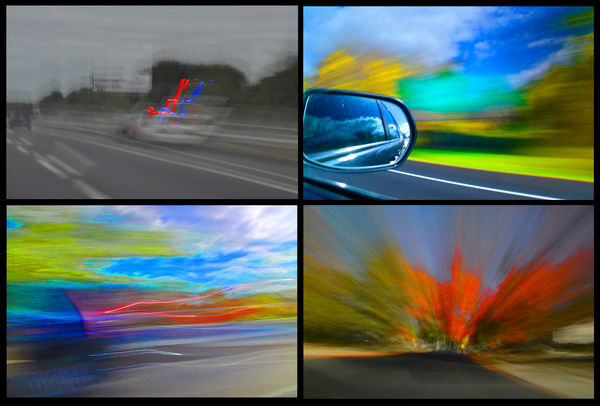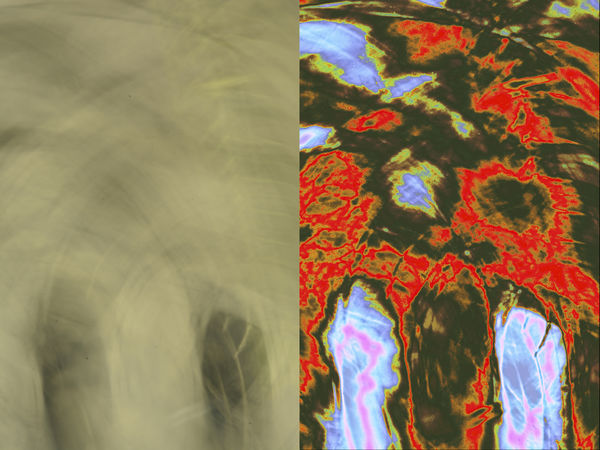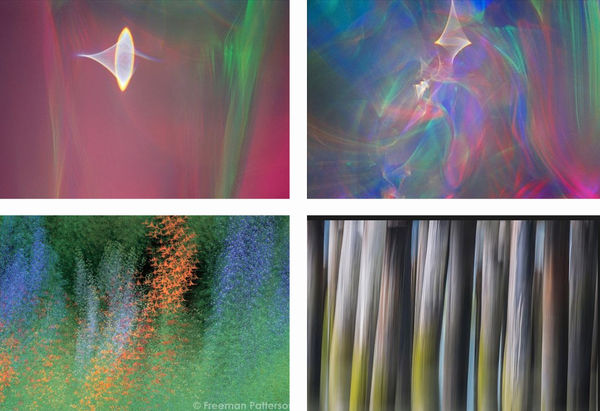Non-representational photography
Jun 25, 2018 09:02:13 #
saidel42
Loc: NJ
I'm posting two images because I've been trying to figure out how to use the camera for creating images that are not strictly there. The first is an attempt to use the camera as an eyeball. (I am a visual scientist and know about eyes. When we see, the eye automatically centers and focuses with the fovea and we see other parts of the visual field because the eye moves so the focal point moves. Long story...boring if you are not interested. Image wise, that means only a small part of the visual field is in focus at any instant.) Obviously, the top 4 were taken from a moving car and then I saturated the colors in PS. (2 ND filters used to provide an 18 strength, exposure varied from 1/4s to 1s.) The upper right with the mirror is close to what I wanted...the mirror in focus (not quite but close) and the remainder of the image transformed.
The lower image is more interesting. It was never there. The original is on the left. I took it from a train window with an 18-105mm zoom pressed against the window. The exposure was 1/4s and as I found something outside interesting to try, I rotated the camera so the 105mm setting simultaneously reversed to 18mm. Given the total pixel range, I was able to play with coloring in PS.
My issue and why I put these out is, especially for the lower image (which I named Two Towers), is what are they and does anyone know of a history of this type of graphics?
The lower image is more interesting. It was never there. The original is on the left. I took it from a train window with an 18-105mm zoom pressed against the window. The exposure was 1/4s and as I found something outside interesting to try, I rotated the camera so the 105mm setting simultaneously reversed to 18mm. Given the total pixel range, I was able to play with coloring in PS.
My issue and why I put these out is, especially for the lower image (which I named Two Towers), is what are they and does anyone know of a history of this type of graphics?


Jun 25, 2018 09:11:20 #
I like what you are showing. Imaging is Imaging. Abstract and Imaging manipulation seems to be coming into it's own.
 Don
Don
 Don
DonJun 25, 2018 09:13:14 #
Offhand, I'd call it abstract photography. Others with expertise may offer a better description.
saidel42 wrote:
I'm posting two images because I've been trying to... (show quote)
Jun 26, 2018 07:50:35 #
Jun 26, 2018 11:00:08 #
My understanding is "abstract" is an image with a recognizable subject- i.e., Picasso's later work was mostly abstract in that human, animal or plant forms were recognizable as such but not accurately represented. Non-objective images offer no corollary to an known physical object, i.e., non-physical subjects; emotion, sound, aroma or tactile events may be depicted by shape, color/hue/value, placement within the presentation. Jackson Pollack's work with paint platters is non-objective...
I like the rear view mirror image - cool!
I like the rear view mirror image - cool!
Jun 26, 2018 11:32:12 #
I agree with your analysis. In photography, the OP might want to Google Freeman Patterson's work.
fuminous wrote:
My understanding is "abstract" is an ima... (show quote)
Jun 26, 2018 16:57:52 #
Of the first four, the top left does nothing for me but the other three are very striking. The mirror shot is excellent. The colours of all three are a big contributor to their success and your imagination is to be congratulated. Truly artistic.
The lower two I find less striking but certainly interesting.
Not sure you’re going to get a huge response from Gallery - perhaps choose one of the more specialist sections to solicit views?
The lower two I find less striking but certainly interesting.
Not sure you’re going to get a huge response from Gallery - perhaps choose one of the more specialist sections to solicit views?
Jun 29, 2018 12:20:49 #
Some of Freeman Patterson's non-representational work.
Fotoartist wrote:
I agree with your analysis. In photography, the OP might want to Google Freeman Patterson's work.

If you want to reply, then register here. Registration is free and your account is created instantly, so you can post right away.





